My trip started in South West Spain, the Andalusia region, home of woderful cities such as Sevilla, Malaga, Granada, Cordoba... I chose this destination because of: the warm climate (the latitude is the same as Sicily), it is in Europe (no problem with money exchange and visa), relatively cheap, nice people, and the best thing you can do in life: tapa y cerveza.
MALAGA
Malaga (570k people), is a seaside town, sister of Barcelina and Valenia, but smaller. Then, should be visited after you came to Barca or Valencia, which have more to show. But Malaga is an awesome city to live for a period. Is much less chaotic/dirty then Barcelona, less stressful and is sunny 350 days per day (the walking tour guy said). Is the city of Picasso and Antonio Banderas. The citycenter is lovely, and it has a big airport at 20 minutes by bus for the citycenter. I stayed here the first 1 week in a very nice rooptop hostel. (Google Chome cannot open the cover image of Malaga idk why)
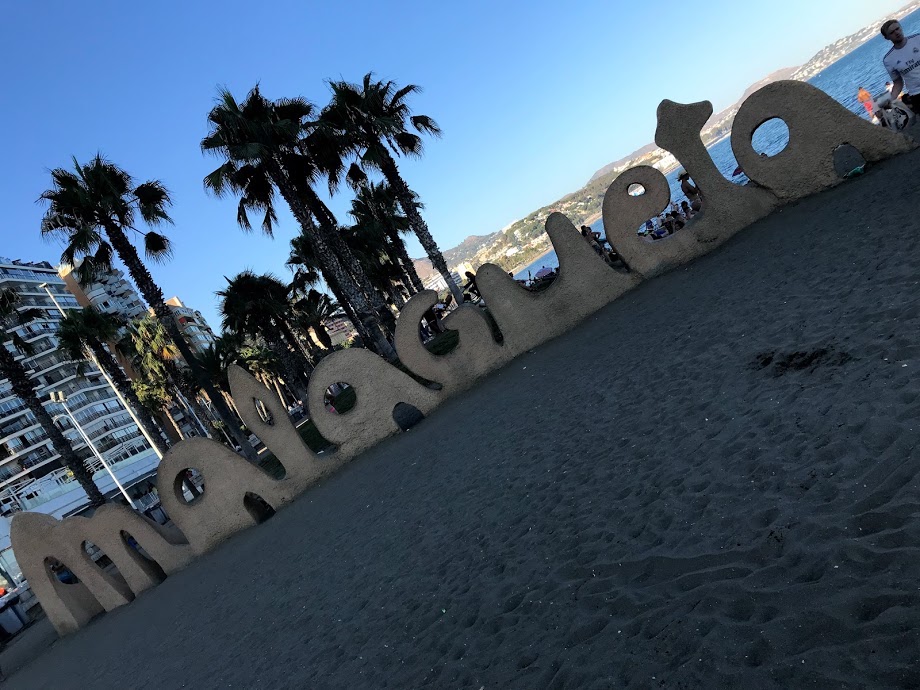
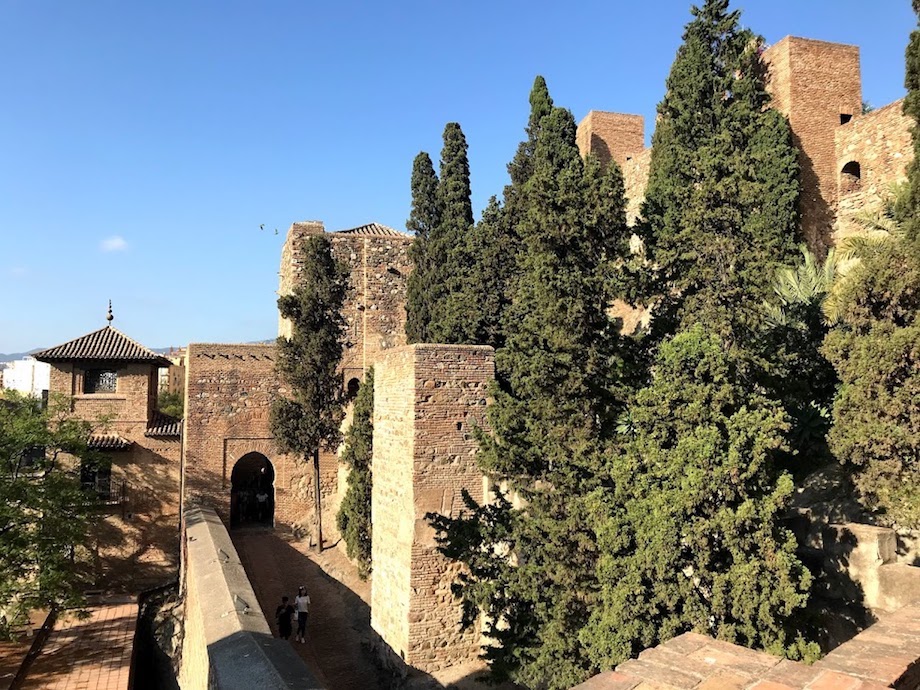
Alcazaba is the muslim fortress built during the 700 years Arab occupation of Spain. There are a bunch spread around Andalusia: the Alhambra in Granada is the most important and the biggest. Malaga's Alcazaba is like a small Alhambra, with little Arab-style gardens, patios and rooms. From the top you have a nice view of the city and of the sea (which Alhambra hasn't).
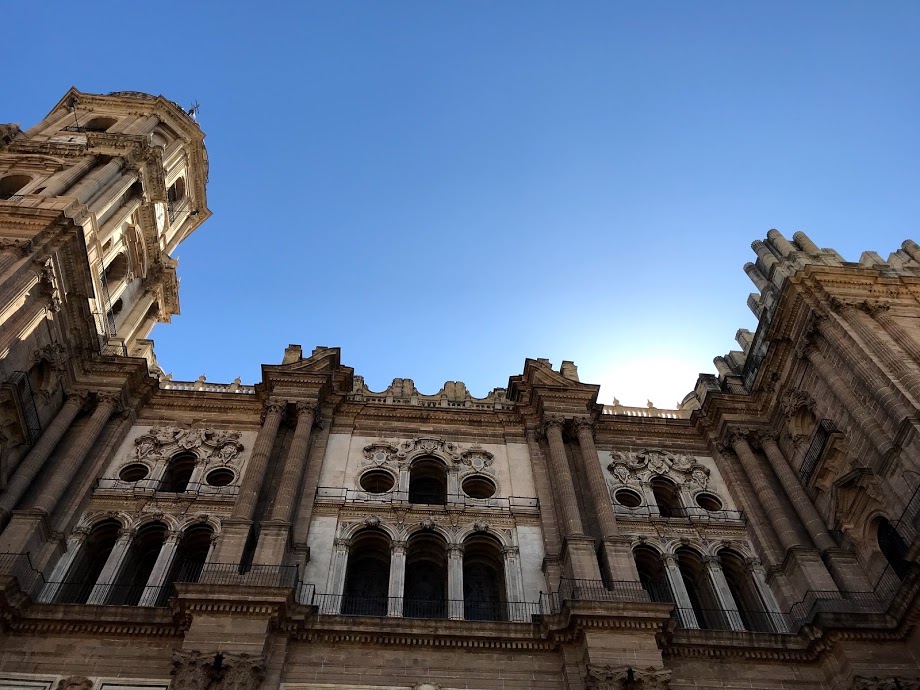
This is the Malaga cathedral. Is very big, and you can notice there were supposed to be 2 towers, but there is one only. For this reason is dubbed "La Manquita" (the arm-less, quite gross). A very typical Spanish issue that you hear in every city you go, is that there are always huge hystorical monuments which were clearly left incoplete beacuse they run out of money. Here you have an example. In the past they found the money to finish it, but Malaguenos were already very attached to their Manquita, so it remained as it is.
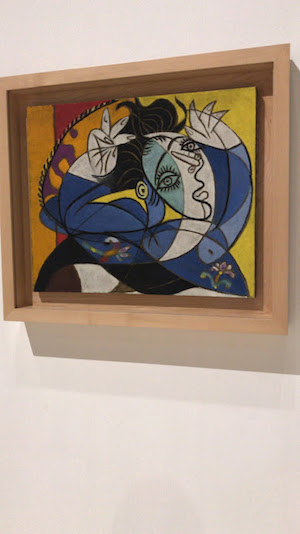
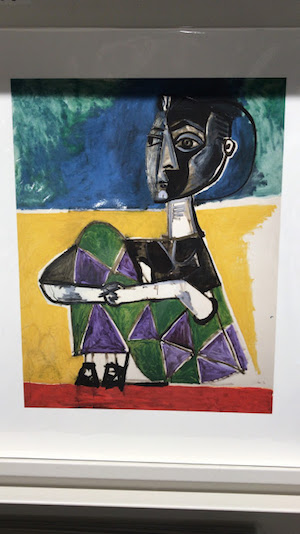
Malaga is the hometown of Pablo Picasso (1881-1973), so the Picasso Museum is one of the main attractions in Malaga. While the mayor masterpiece are stored elsewere (Guernica is at the Reina Sofia in Madrid, and the "Les demoiselles d'Avignon" is at the Moma in Nyc), there are nice painings. Jacqueline Sentada was my favourite, where Picasso's muse and second wife Jacqueline Roque is potrayed
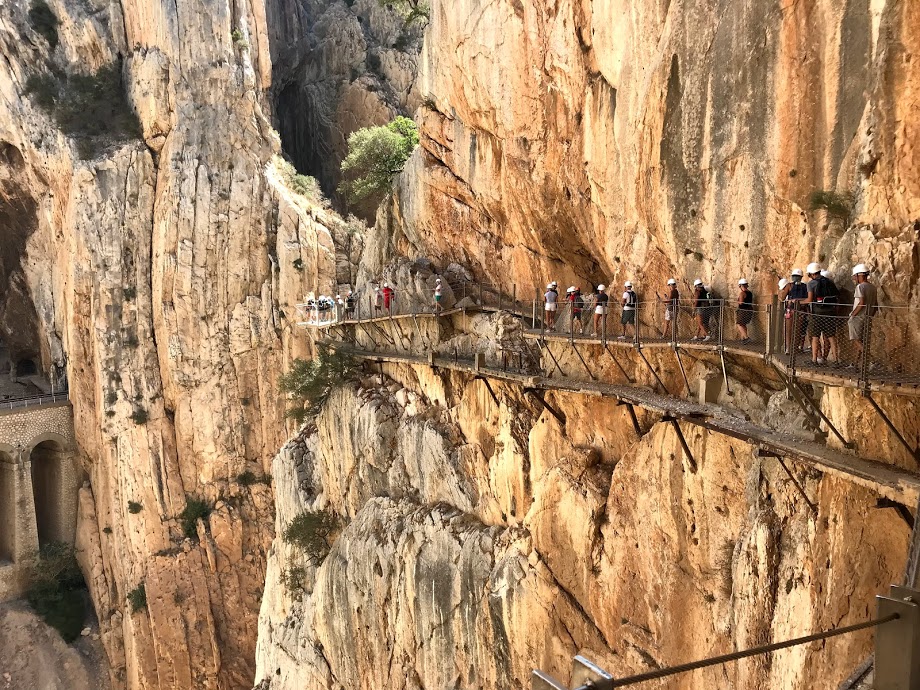
40 minutes by bus from Malaga, there is the Camnito del Rey. Is a very high walkaway situated in the mountains of El Chorro village. You walk along 3km of footbridge pinned to vertical rock wall. The view is very nice, with waterfall and woods around you. Before its rennovation in 2015, it was the destinatio for many adventurous climbers. After the death of 5 people, they decided to build a safe walkaway and open it to the public.
I accidentally and luckly came to Malaga during the week of the biggest annual party: la Feria de Malaga. They party from early afternoon until the morning of the following day. Here you see a video to get the athmosphere during this week and how much Spanish people like to party. Here eveyone can dance really good, and the reason is explained in the second video. It was 5 in the morning, I was of course very tired and I wanted to go home, but I stopped looking these little girls still dancing like crazy. Now you understand.
GRANADA
Granada (240k people) is the first city where I volunteer in a hostel. It is a precious city, known for 2 Unesco World Heritage Sites: the Alhambra and the Barrio of Albaicin. My hostel, Makuto Hostel, was in the heart of Albaicin, the oldest part of the city. I spent two months here, I started leaning Spanish and coding, took salsa classes, made the tour guide for the guests, leart how to make mojitos and cook for 20. Most important, met many cool people. It was an exciting start.

The reason why you should visit Granada: the Alhambra. Is a massive fortress which dominates the city. Was the residence of the sultan during the 700 years arabic occupation (711-1492dc). Nowadays represent 95% of Granada GDP (Im exaggerating), thanks to the tourists coming from all over the world to see it. Is the second most-visited monument in Spain after the Sagrada Familia. In the background, the Sierra Nevada, the highest mountain in continental Spain (the highest in in the Caray Islands). On winter, with the snow, the view should be very spectacular. Book the tickets weeks in advance OR at midnight sharp of the same day on the ufficial website. The picure is taken from the famous Mirador de San Nicolas in Albaicin.
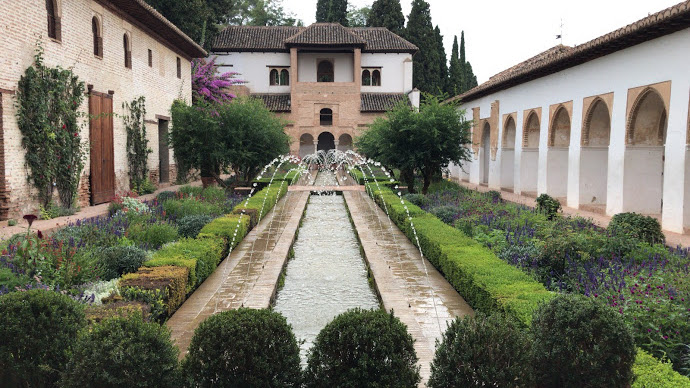
Inside, the Alhambra is composed by 4 main spots: the Alcazaba (miliary fortress), the Palace of Charles V, Generalife and the Nasrid Palaces. Generalife (pronounced "hhhhh eneral y fe", and not insurance-company-style-name "general life"), was the summer residence of the sultant (200m from home and not on the beach... what a holiday!). The gardens are very beaufitul, with waterways, foundains, flowers... You can distinuish this part from the rest of the Alhambra for its pure white color, in contrast with the red-brick of the fortress.
The Nasard Palaces were the actual residence of the sultan. Is a complex of many precious palaces with amazing arab decorations. Just imagine how long did it take to carve all the decoration of huge walls and rooftop. There is a magic Alladin athosphere inside the rooms, with the soft-light of the bright sun of Granda coming through the dark windows. The Nasrids were the last arabic dynasty occupying Spain until the Reconquista by the Catholic Kings Isabel I of Castille and Ferdinand II of Aragon in 1492. The Nasrids started building the Alhambra in 1232 to impress visitors and celebrate the muslim power in the rest of the world.
The view from one of the towers of the Alcazaba, the miliary fortress of the Alhambra. Much less frills and more robustness, it served as watchpoint to protect the sultan form invasions. In fact, the view from here is very broad and nice. Here you see the Albaicin neighbourhood, the most beautiful part of Granada. A labirinth of white narrow street that climbs on the hill of Sacromonte. Living in Albaicin is estetically very nice, but climbing the hill everytime you had to come back home from the grociery... not so functional (except for your butt).
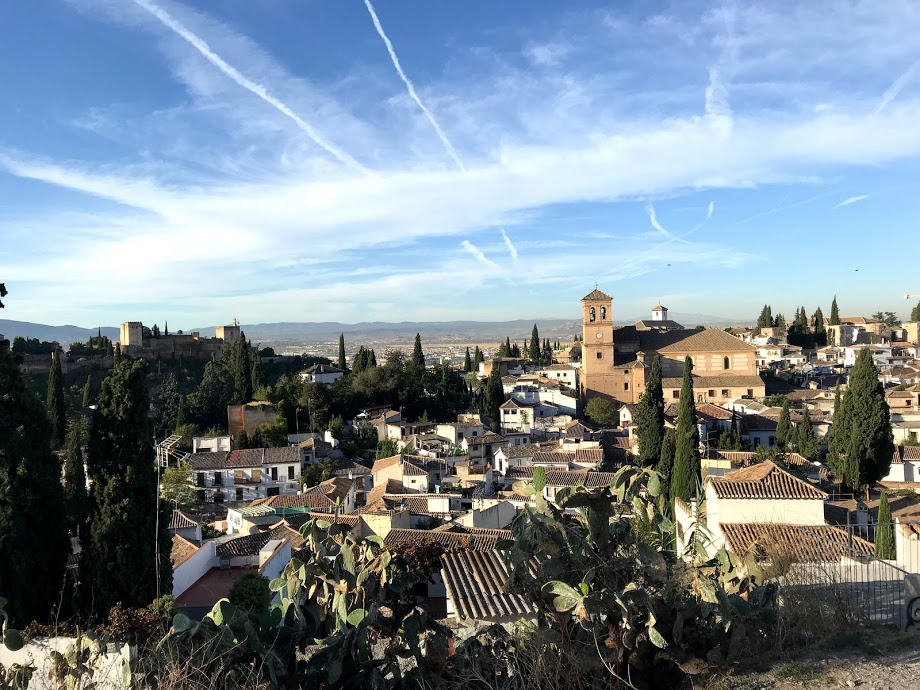
The Barrio (neighborhood) of Albaicin. It is the oldest part of the city, surrrounded by a wall. Maze-style narrow street protects the habitants from the hot Andalusian summers. It was the muslim part of the city before the "Christinaization" from the Catholic Kings. Is a place where to get lost and explore, until you find one of the many "Miradores" from where you get a view of the entire city from the top, and of course a view of the Alhambra (very nice/romantic in the night). There are a lot of street artist around playing flamenco, and a considerable amount of hippies consuming a considerable amout of recreational essence.

As part of my voluneering activity, I had to be the guide in free walking tours for the guest organized by the hostel. It sounded hard at the beginning, but if you learn 20 facts about the city, 3 dates, 3 names is more than enough. People were even asking me if I were from Granada after my amazing explanation of the of the origin of the name Granada (means pomegranate because there are pomegrates here... wohoo!). For the question that you do not know, you can say whatever BS you want: noone fact-checks, and even if someone does, he/she ask the money back... Cause it is free! Genius. The final part of the tour was the most spectacular: watching the amazing sunset of Granda from the top of Albaicin: el Mirador de San Miguel. The city and the Alhambra light up and the sky is burns. Here is a group pic with my guest. Asking for tips was a way to finance my trip. So even if you volunteer, there are some activities you can do for earning something.
This is the place where I was living. Makuto Hostel is one of the best in term of social life. The rooms where around a nice patio where the social life took place: breakfast together, playing cards, playing chess, chitchatting, (I even organized a workshop of cybersecurity hosted by a very smart guest), family dinners (cooking for 20 people once a week was part of my duties, and evenryone was happy for my stupid "Amazing Original Italian" pasta with plain tomato sauce), guitar, songs and drinks... Here I met people mainly from US, Australia, Canada, New Zeland, Israel, UK, France, Germany. This is a scene from lunchtime, when everyone is visitng the city and I had time for learn coding. You can see I am super focused ina comfortable position, and I already type like an hacker.
Another awesome and very profitable way to finance you trip is to go to play on the street with your colleague Leonardo and Luciano Di Pasquale, the Argentinian guy who introduced me to HTML (juventus T-shirt). We did it only one day, and Luciano was free-styling on Leonardo's guitar reefs. Rap on a ballad, the new fronteer of music. We receive the first money (the starting money in the guitar-case were our coins) after I started to play Ed Sheeran and a couple of old ladies came to me asking the title of the song (Photograph). In the meanwhie, the other 2 guys were playing football on the square. We earned 80 cents that day, to be split in 3, even if I claimed a bigger 50% share for my success.

The Mojito and Paella night was my favourite event of the hostel. We had to prepare dozens of mojitos for the guest, but we could drink as much as we wanted. Here is my last night with Sierra from US, Elena from Spain, Leo and Lulu from Italy. Lulu was my boss, and we used to go to the clubs twerking AF (who twerks with its boss?). Honorable mentions not in the picture: Mila from Ukraine, Alberto from Italy, Lidia from Latvia (or Estonia or Lituania I never remember), Neekita from India, Yuval and Jonathan from Israel, Wesley from US, Jannis from Greece, Luciano di Pasquale the best, and many others. Thank you guys!
CORDOBA
Cordoba (330k people), is maybe my favourite Spanish city (I cannot chose between Cordoba and Sevilla). It was the capital of Spain under the muslims, and become, after Costantinopoli, the biggest city and influential in the world in the X century. The citycenter is lovely. The Mezquita alone makes worth any trip to Spain.

Cordoba is beautiful wherever you look. The houses color is pure white, with yellow balconies, black fences, and accurately decorated with blue-vase flowers hanged to the walls. There is a very cozy and warm athosphere in Cordoba. The green of the heavenly parks makes the perfect constrast with the blue of the sky. If you go, you will be enchanted by Cordoba and its colors.

Cordoba is also famous for the patios of its houses. They make even an annual competition to elect the most beautiful patio of the city. Here I am in Palacio de Viana, a big aristocratic house with 13 big patios, each one with a very different style and plants. Very very very beautiful.
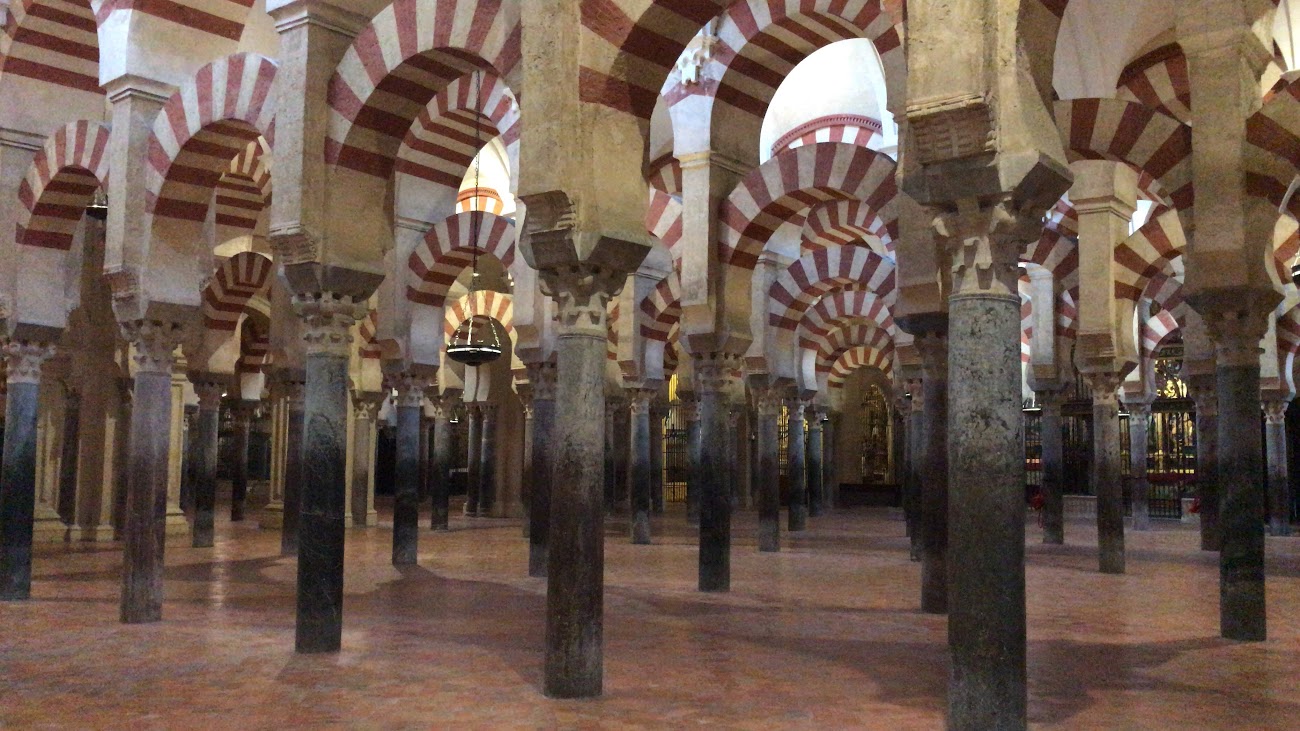
Now we arrive to what I consider the most beautiful thing I have seen in my trip to Spain: The Mezquita of Cordoba. Was the main mosque of the city, but I was turned to church after the Reconquista, and it is still Christian nowadays. It is composed of hundres of double-arch supported by a labirinth of columns. It is really stunning. Seems like you are inside a kaleidoscope. I suggest to go early in the morning as soon as it open because is free, and, most important, you manage to take a picture without people (10 seconds after I took this picture it was already crowded). In picture takes just a small portion of the entire space of the building.

Standing on the Roman Bridge allows you to see the Mezquita and all Cordoba. It is beautiful to come here both in the night and during the day. I will definetly come back to Cordoba one day (I missed to see the Alcazar de Los Reyes Cristianos).
SEVILLA
Sevilla (690k people) is the capital city of Andalusia, and the 4th biggest city in Spain after Madrid, Barcelona and Valencia. It is a city you must see once in your life. It is muy hermosa. I was volunteering for 1 month in Hostel One Catedral, a splendid hostel in the heart of the Barrio de Santa Cruz, which is incredibly beautiful. Sevilla was a very important and rich city in the past, being the economic capital for the trading with the New World during the XV Century. It is full of history (after Rome, is the city with the highest number of curches in the world), the temperature is spectacular, the sky is clear, and there are many things to see. It is a place where I would like to live for a period.
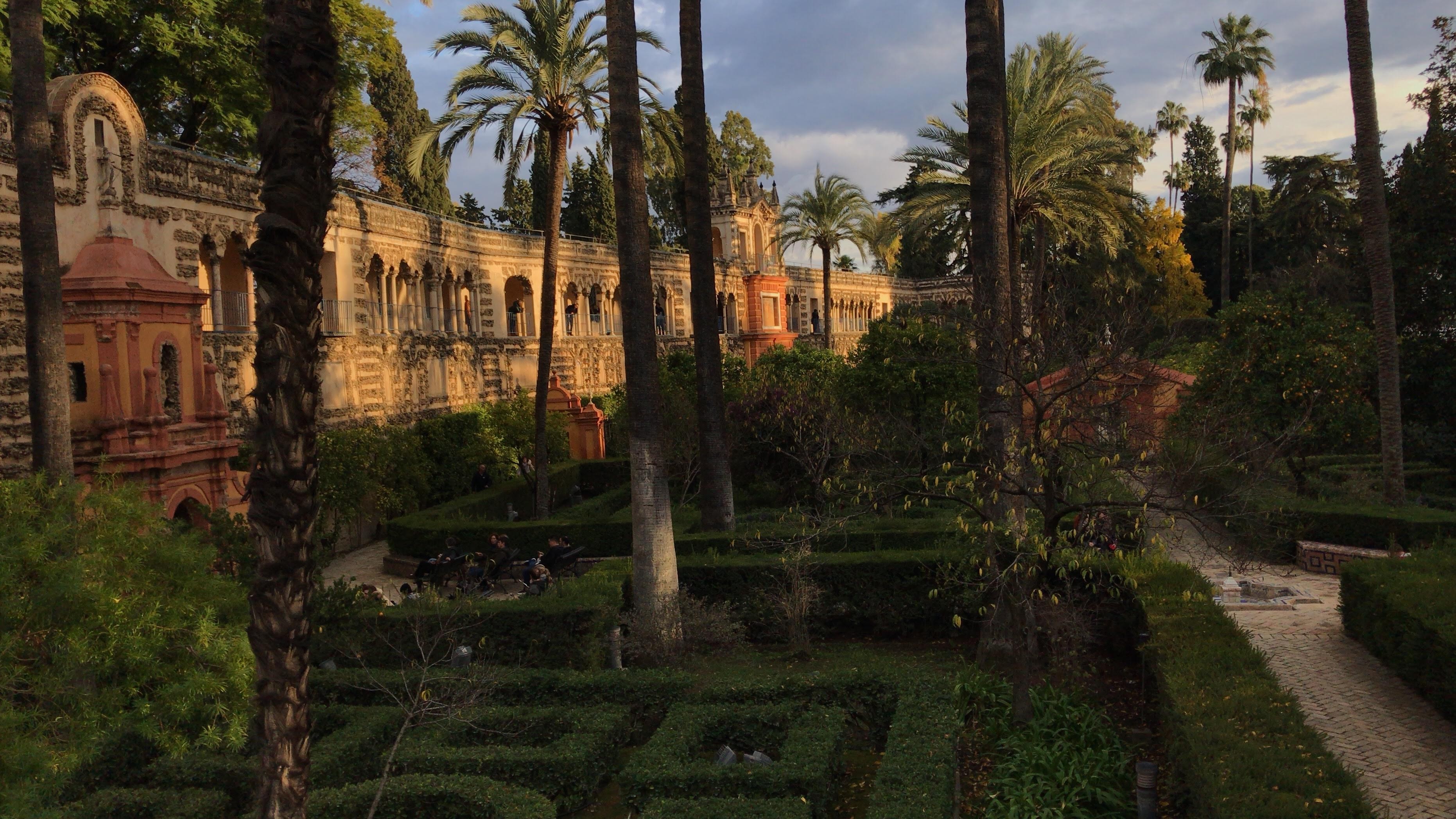
The Alhambra's sister, declared Unesco World Heritage too. The Real Alcazar is a Real Palace which still hosts nowadays the real family during their staying in Sevilla. It is famous for being one of the place where Game of Thrones was filmed (shame on me, I ve never seen GOT). The big palace is situated in the center of the city, surrounded by beautiful cernellated walls. There are more different sections contitution the palaces, each with different style, from Renaissance, to Gothic, to Alhambra-Style Mudejar (many rooms are similar to the Nasrid Palace). The best part are the idyllic gardens of the palace, where hedges, palm trees, pavillons and covered walkways contributes to the heavenly atmosphere.

The biggest gothic catedral in the world (bigger than Duomo di Milano). It was built between 1434 and 1517 over the main mosque of the city. Inside, you can find ONE OF the Cristoforo Columbus tombs, which apparently had different parts of the body in very different parts of the world. After a long queue and 35 ramps, you can get up the clock tower, the Giralda, which was the minaret of the previous mosque. It has the same proportions of the Koutoubia Mosque in Marrakech. From there, you have a beaufiful view of Sevilla and the Catedral from the top (just a portion of the Catedral fit in the picture). In this shoot, you can also see the circular Plaza Del Toro and the Torre Sevilla contrasting the shallow white houses.
Plaza de España is one of the most facinating square in the world. It seems quite historical as a square, but it was built in 1929 for the Iberoamerican Expo. A mix of Baroque, Art Deco and Moorish style half-circle builing surrounds the square. Venetian-style bridges decorated with blue-tiled cross the water canals streaming in the middle. You can also rent a boat and take a sail in the middle of this spectacular Plaza. Along the builings, in the base, there are 48 "banches" made of coloful tiles representing each Spanish region. Each bench often contains typical representations and map about its own province. A walk in the night or during the sunset is a very suggestive experience.
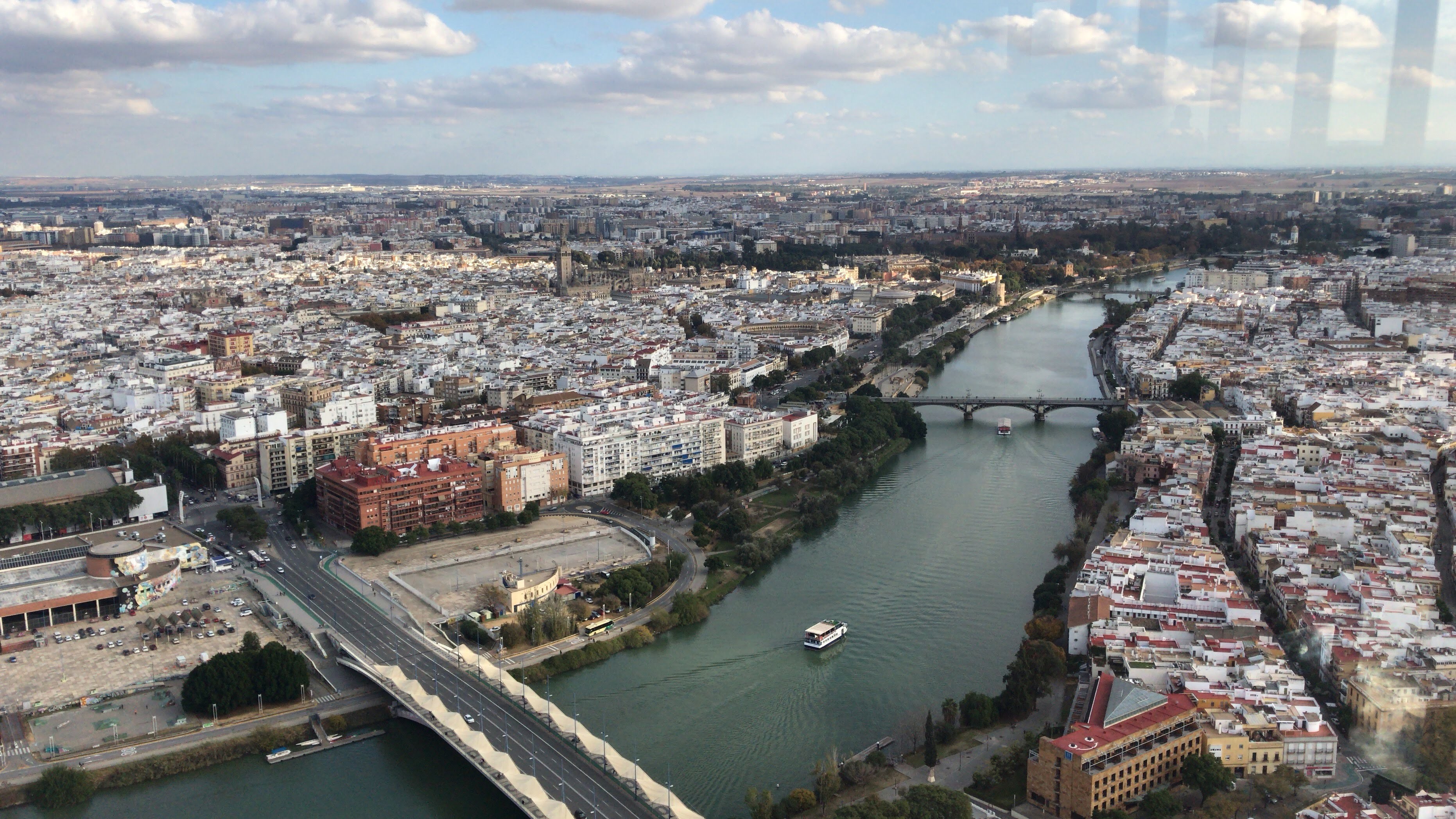
I love skyscrapers, and I try to get on the highest structure in every city I visit. In Sevilla, it is the Torre Sevilla, 181m, the 7th highest in Spain. While checking it, I discover that a Spanish city called Benidorm is the first city in the world in term of skyscrapers per capita. Very misterious city. Anyway, Torre Sevilla rises on the other side of the artificial canal cutting Sevilla in two. You get up with 8€ against the 3€ of the Setas. But is not crowded at all, there is a bar (expensive) on the roof and some couches where you can stay and use the Wifi. Nice place for a stylish pit-stop with a stunning view.
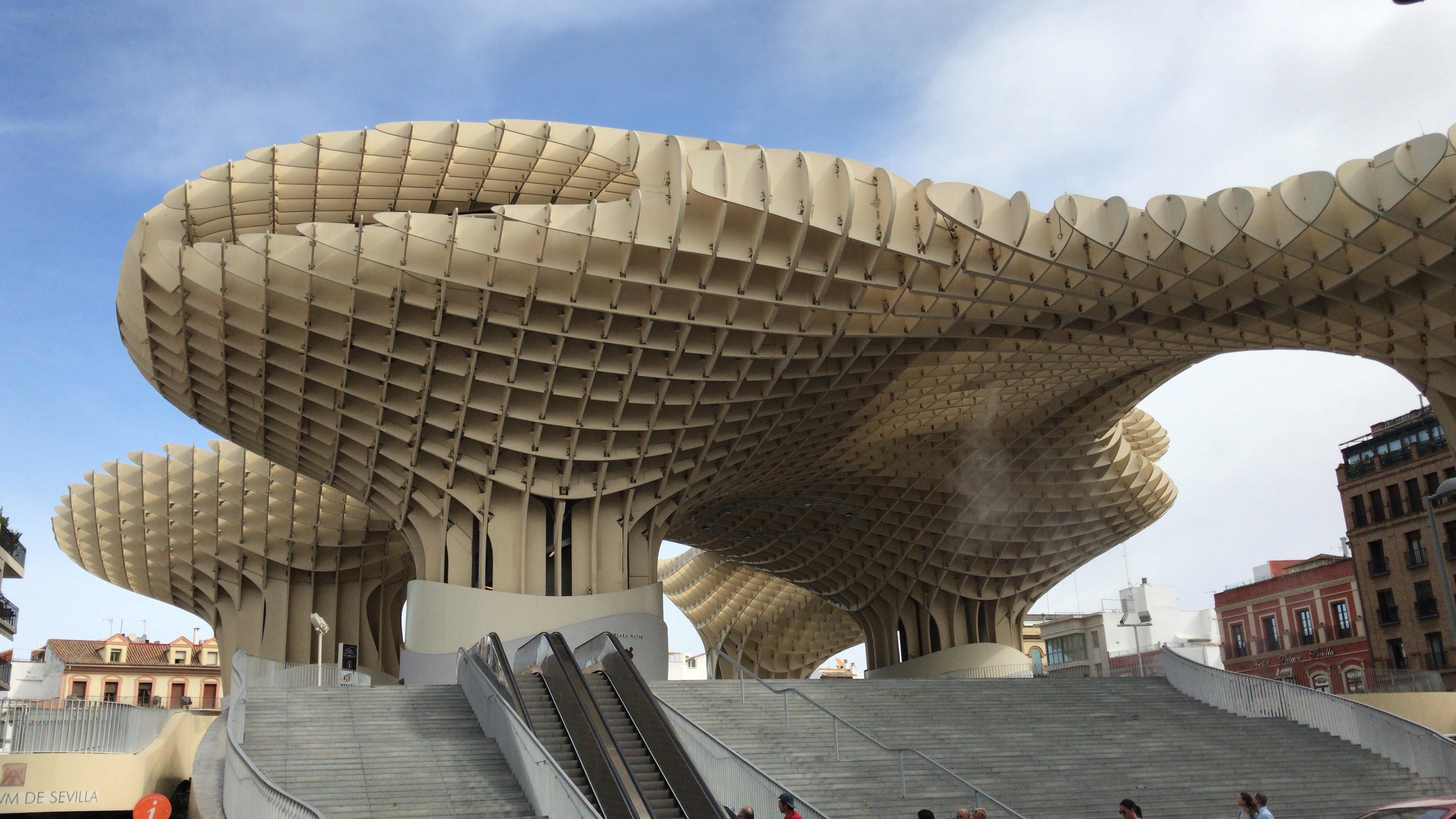
Las "Setas de Sevilla", or "Metropol Parasol" or "Mushroom" ("Seta" means "mushroom" in Spanish), is a controversial structure built in 2011 by German architect Jurgen Mayer. Does't seem like, but is make of wood. And it is the biggest wooden structure in the world (26 meters heigh). You can go up to have a beautiful view of Sevile from the walkway going through the hollow roof. Many people considered it ugly, and maybe it is. Moreover, it was super expentive (50 mln Euro projected, actual costs 100millions Euro...). But I find it fasinating. Go up for 3€ for a beautiful view of the city and enjoy the sunset.
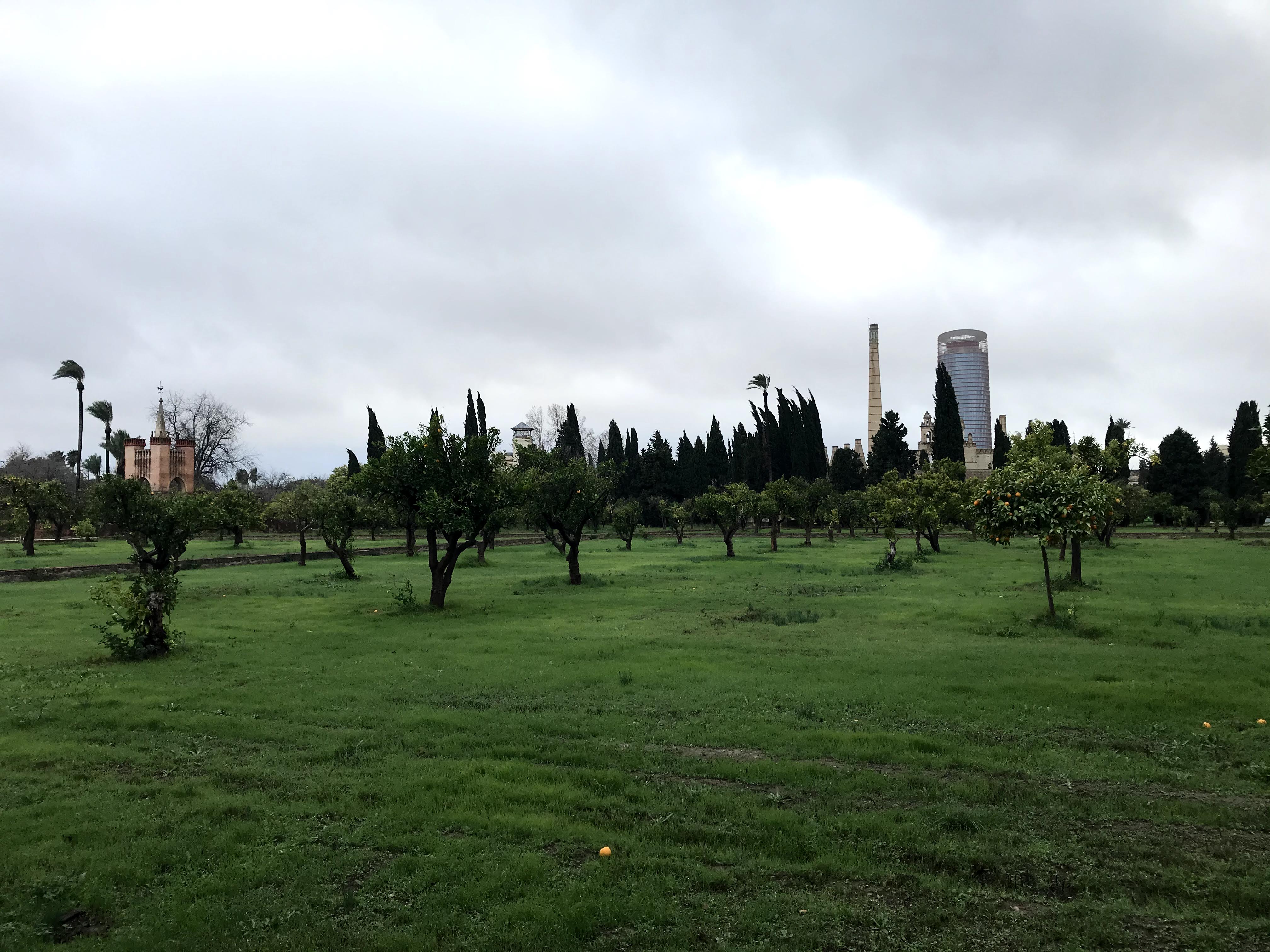
This is an interesting place. Unfortunately the weather was not the best, so the picture does not really bring justice to the place. It is a big field of orange trees in the backyard of the Centro Andaluz de Arte Contemporaneo. On the ohter side of the Guadalquivir, which cut Sevilla in two, there is the site where the Expo 1992 was hosted. It is full of strange and interesting structures built for the occasion. As many of former Expo location, it is a little ghost town with strange builidng around. Worth a visit. Exploring around, I ended up in this big garden. Take and eat the oranges form the many trees (the ones in the citycenter are super acids). If you feel like going to the countryside, you have a piece of it 10 minutes walk from the citycenter of Sevilla. Closeby, take a look to the Monastero di Santa Maria de las Cuevas, CaixaForum Sevilla, Junta de Andalucia, JRC-Seville and many other achitectures.

Also known as La Maestranza, it is the oldest Plaza del Toro in Spain. It contains 12.000 people during the Corridas which take place from April to October. They organize half an hour tour where you realize how much tradition and culture there is behind la Corrida, despite being a controversial thing. There was a sense of stillness while staying in the middle of such a big arena in the night with no poeple around.
CADIZ
Cadiz (120k people), is one of the oldest city in Europe. It was founded by the Phoenicians thousands of years BC. It was a very important and rich city, thanks to its strategic position in the SouthWest Europe, close to the Strait of Gibraltar, and facing the Atlantic Ocean. The old part of the city is stuated on the top of an island, linked to the mainland through the massive Puente de La Pepa. It is a very nice city. The citycenter is small but with a lot of beautiful architecture and squares, a big cathedral as in all the Spanish cities, wide and sandy beaches, and very pretty parks along the seaside.
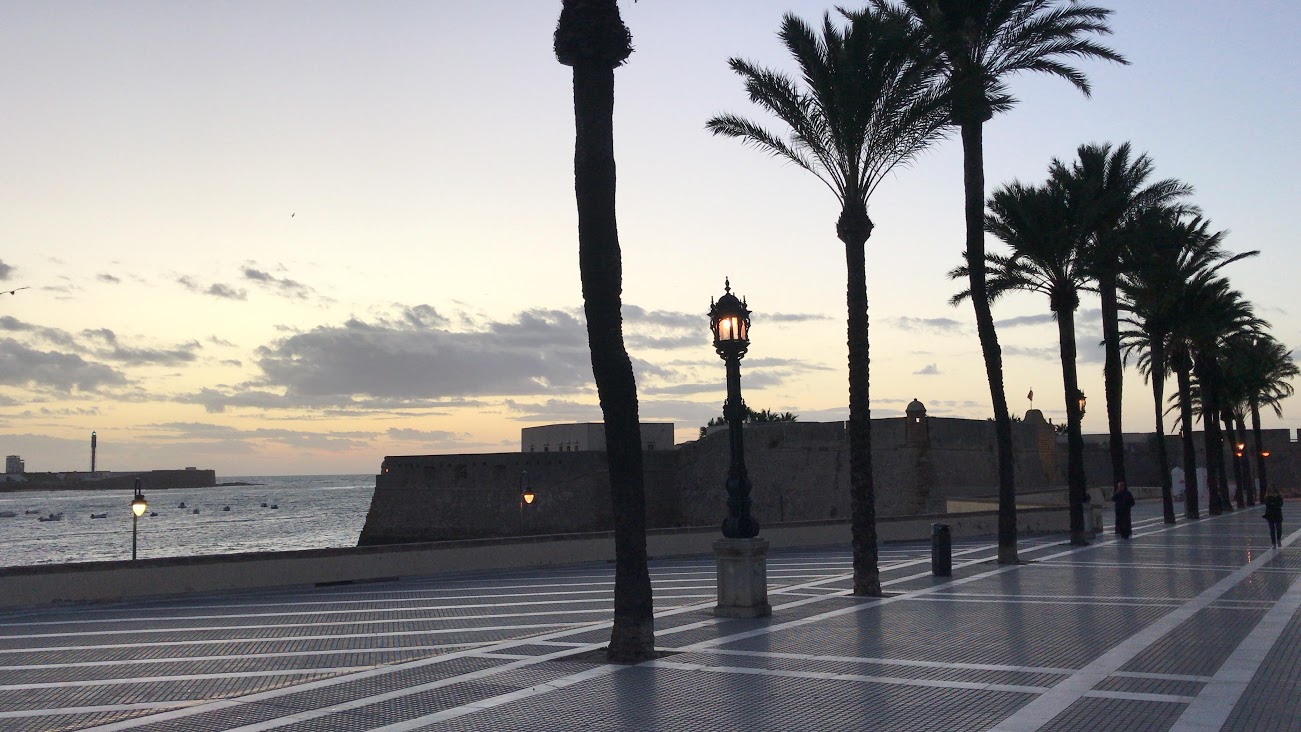
Cadiz is a city to live in summer; in autumn is pretty empty and quiet. But offers a very nice views on the ocean all year long. Is not that cold being in the Southest Part of Europe, but the wind is strong. There are a lot of pretty small-fortress overlooking the sea. I was here in November, working in a hostel. Tip: if you go to work in a hostel off-season in a seaside city like Cadiz, you have not so much work to do, and you have tons of time to focus on your things. We were 2 voluneers, and there were on average 4 guests per night, 2 hours per day of work. Very calm.
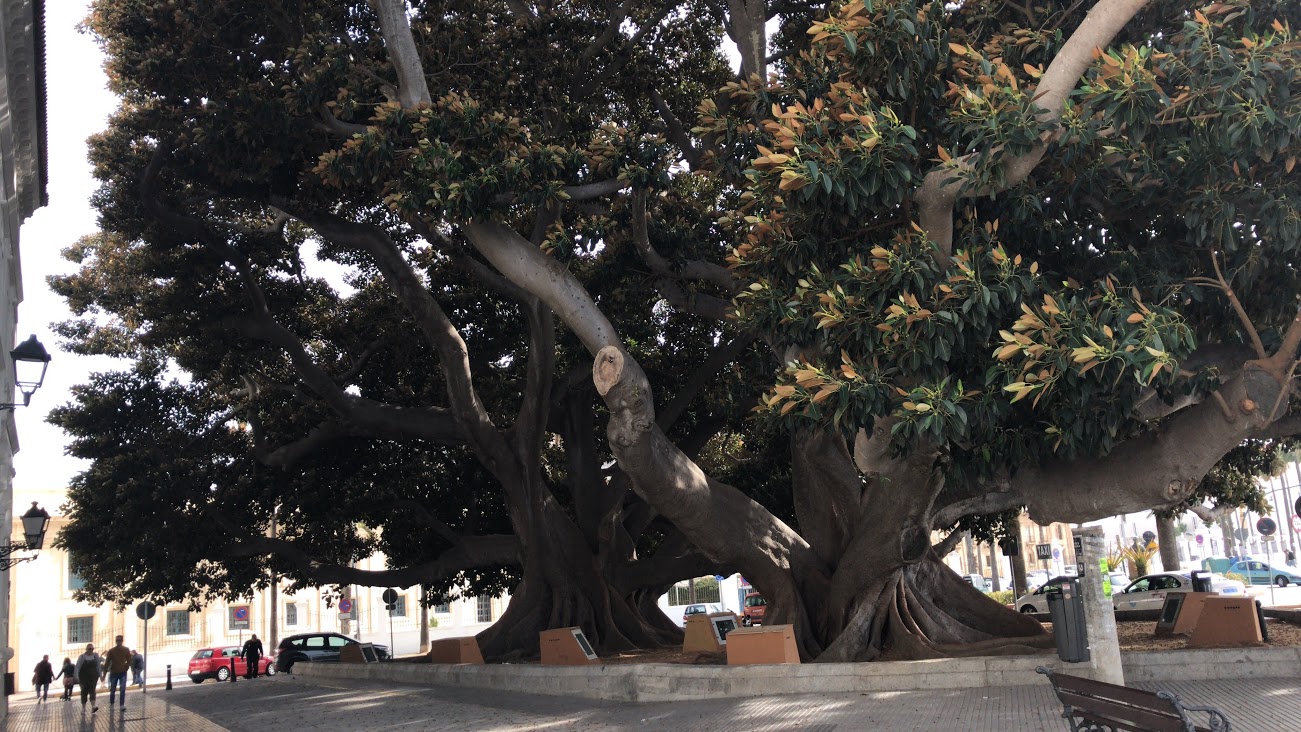
Near the University of Cadiz, close to the Playa de la Caleta, there are two huge trees. They are more than 100 years old, so it is almost like to see two monuments. The technical name is Ficus Macrophylla and they were "imported" from Australia. I saw the same type of trees in Alicante and Valencia, so I guess they might me typical for the Spanish costal cities. They are impressive.
One hour and a half by bus from Cadiz, there is Tarifa, which is the city on the tip of Europe (I am sorry, the Strait of Gibraltar is not exacly on the tip). Tarifa is similar than Cadiz, but smaller. It is also a good destination for you summer holidays, especially if you like to surf: it is very windy, and you always find good waves. In this rainy day there were a lot of people Kite-Surfing on the playa, making jumps of 2 meters. Here you have a view of the watershed dividing the Mediterranean Sea and the Altantic Ocean. From Tarifa you can see the cost of Morocco. It is incredible how close it is (15km). Interesting.

Like all the highly-respected activities you could do in you "Gap Year/Months", here is me on my first surf class in Cadiz. I felt really cool on my black-Diabolic wetsuit, it makes your body look fit. Moreover, handling a surf-board makes you feel like a cool Californian guy who doesnt give a shit. The water was cold, but it is crazy how well these suits work. I didnt feel cold at all in the body. But my feet and my toes where completely freezed. I couldn't feel them, and smetime I was checking if they were still attached. Being in the middle of the sea and watch the sunset in November was an unique experience.
La prima de Barceloneta: la Malagueta. Is the beach in the citycenter of Malaga. Despite the port, the water is very nice. A cool thing about this beach is that, instead of gery pigeones, there are funny green birds that contributes to the hexotic athmosphere together with the palm trees. There are a lot of bars along the beach, and in the background you can see the Alcazaba.